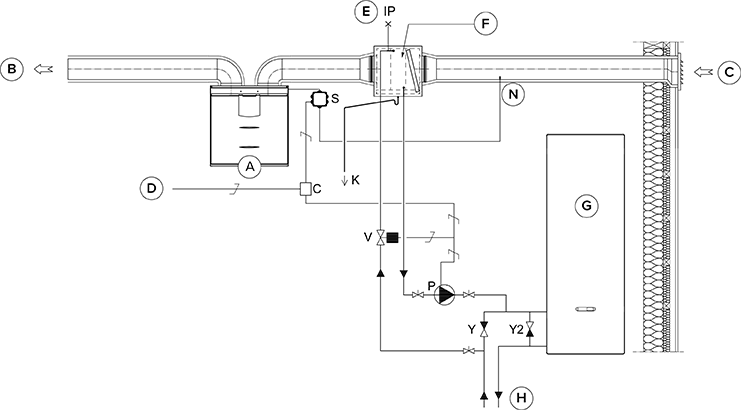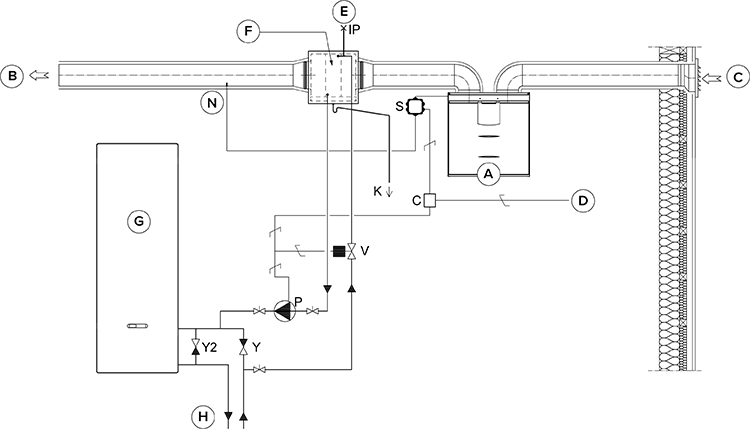Duct radiator operation
Always follow first and foremost the connection diagram provided by the HVAC designer or heat pump manufacturer. Also read the duct radiator manual.
The accompanying figure shows an example of the arrangement for connecting the heating/cooling radiator unit to the heat collection circuit.
If the duct radiator is used in the supply air duct, it can only be used for cooling.
Connect the radiator output pipe to the heat collection circuit return pipe. Direct the fluid returning from the radiator unit to the heat collection circuit return pipe. If you know that there is a large loss of internal pressure inside the heat pump, the heat pump should be bypassed. If this is done, the fluid circuit will come into operation when the heat pump comes to a halt. When this happens the pressure loss in the one-way bypass valve Y2 must be lower than the pressure loss in the heat pump.
Heating: The pump starts when the outdoor air temperature drops below the winter limit value set at the factory (-5 °C).
Cooling: The supply air setpoint value for the active mode (for example, At home) controls the pump start-up. The pump starts when the supply air setting is below the temperature of the supply air that is blown into the apartment.
The duct radiator can be installed in both the supply air duct and the outdoor air duct. If the radiator is installed in the outdoor air duct, it can be used for both preheating and cooling. If the radiator is installed in the supply air duct, it can be used for heating or for cooling only.
When used to control the outdoor air duct radiator, the external NTC sensor is installed in the outdoor air duct before the radiator. When used to control the supply air duct radiator, the external NTC sensor is installed after the radiator.
The duct radiator can be set to function either automatically or manually.
To prevent the risk of condensation in the supply air duct, you can set the adjustment of the supply air limit to automatic or manual.
If an external sensor is in use, it is selected from the settings of the external sensor whether it is used to control the outdoor air duct radiator or the supply air duct radiator. The temperature of the external sensor can be read from the service menu: .
When selecting the relay (C), take account of the maximum allowed combined power supply (6W) of the circuit board in the external MV electrical box, if the relay power supply comes from the circuit board’s +24V connector.
Due to the risk of humidity damage, in a duct that has not been insulated for condensation the supply air temperature must not fall below +16 … 20 °C.


- A
- Ventilation unit
- B
- Supply air
- C
- Outdoor air
- D
- Feed from the distribution board
- E
- Air extraction
- F
- Duct radiator (reverse connection)
- G
- Heat pump
- H
- Heat collection circuit
- N
- External NTC sensor for Vallox MV ventilation units
- P
- Circulation pump. Not included in the delivery. The pump should be suited to pumping liquid colder than the surrounding air, due to risk of condensation (for example, Grundfos Magna 1 25-80).
- V
- Solenoid valve. Not included in the delivery. The valve that is chosen must be compatible with the heat collection circuit fluid (for example, Danfoss ELV05006, HVAC code 4122110).
- K
- Condensing water tube. Not included in the delivery.
- IP
- De-aerator. Not included in the delivery.
- S
- External electrical junction box for the MV
- C
- 24 VDC relay/contactor for controlling the pump and the solenoid valve. Not included in the delivery. (For example, ABB CR-P024DC2)
- Y
- One-way valve. Rückschlagventil. Not included in the delivery.
- Y2
- One-way valve. Not included in the delivery. The pressure loss must be less than the pressure loss of the heat pump.
